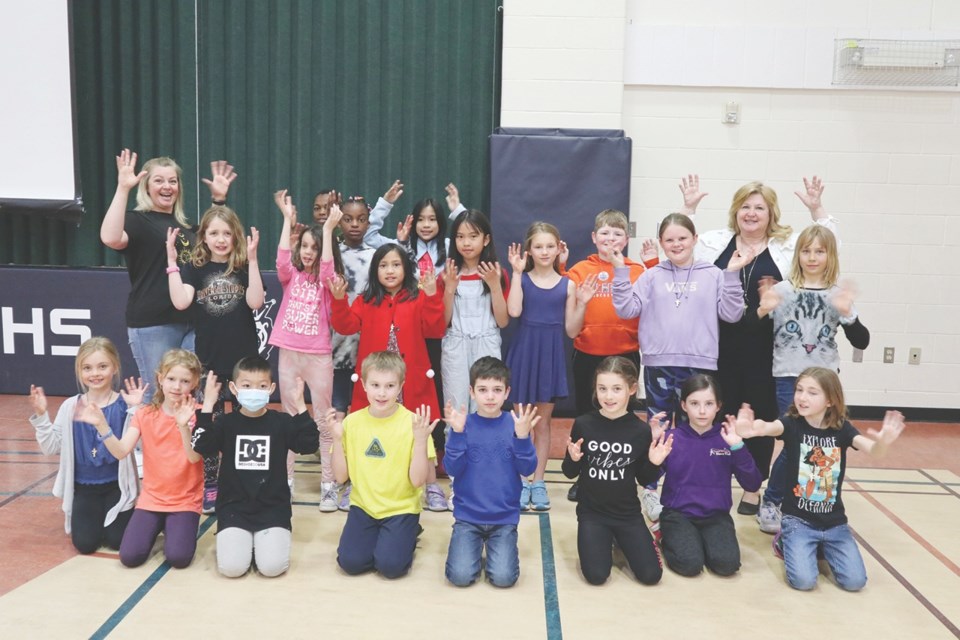ESTEVAN - Dozens of students at St. Mary’s School in Estevan spent the past few months learning about the importance of sign language.
A sign language club was started in February, under the guidance of school librarian Lyse King and kindergarten education assistant Laura O’Hanlon. The students showed what they had learned late last month during a gospel assembly in which they signed the Hail Mary.
“We came up with the Hail Mary because May is the month of Mary, and we thought that would be an appropriate prayer to learn,” said King.
They also wanted to showcase what the students had learned during Catholic Education Week.
The librarian noted she has been teaching her grandchildren how to sign, and she was talking to a few students about it. They thought it was a good idea to form a club.
She also knew that O’Hanlon has learned sign language. King and O’Hanlon approached St. Mary’s principal Ryan Jutras, who gave them the green light.
They started out with about 70 students, although not all of them have remained with the club. Lately they have had around 35 children showing up.
The club meets during recess two days each week. Since St. Mary’s employs a split recess, kids in Grades 4-8 meet during the first break and those in Grades 2 and 3 gather during the second.
The younger grades have been the larger group.
“They have learned signs for colour, feelings, family, animals and some foods,” said O’Hanlon.
Students have also learned the days of the week, the alphabet, and how to count in American Sign Language, added King.
It’s been a lot for the kids to take in.
“I would say that we’ve had a really good response,” said O’Hanlon. “There’s been lots of positive feedback, especially the younger ones who have seen us use sign with some of the students in the past in the school.”
It’s a good opportunity for them to learn another language and learn to communicate with some of their peers.
“The teachers are saying ‘They’re showing me different signs, or how to do this.’ Even with Mr. Jutras, they’re asking Mr. Jutras if he knows how to spell his name in sign language,” said King.
O’Hanlon and King also taught the children how to say “How are you?” in sign language, and so the students will use it to interact in the hallways.
“They’re excited to be learning, and the younger grades are hoping that we will be able to continue next year, and they’ll be able to add onto the basics,” said King.
O’Hanlon noted she was about the same age as some of these kids when she started learning sign language, and that led her to continue learning into adult years.
“It’s something that I am able to use now and communicate with the deaf community, and it’s come in handy as just an additional skill. There’s a lot of benefits to it,” said O’Hanlon.
Several students took time to explain to the Mercury why they have enjoyed being part of the club, including Grade 3s Comfort Abeka, Rosalie Horrocks, Elaina Sliva and Bella Lapitan, and Grade 8s Kylie Ibot, Neveah Wakely, Kathryn Orlowski and Eva Schmidt.
Each student had different reasons for wanting to join the club. They have all learned different things and found their own reasons to enjoy it.
“I’ve liked learning about this new language because I haven’t ever done anything with sign language before,” said Elaina.
“I like being part of the club because I can talk with people in sign language,” said Bella, who looks forward to being part of the club next year.
“I think it’s an important skill to learn, in case someone’s mute or deaf so you can communicate with them,” said Nevaeh, who wants to take professional sign language classes.
“It would be very beneficial for getting jobs and other things like that, because you have a better understanding of people around the world as well,” said Kathryn.
“I think it’s important to learn something new, and it will probably benefit me later in life,” said Eva.
The older students expect they will continue to learn sign langue once they are no longer at the school.
King noted she started teaching sign language to her grandkids because it makes connections with the brain, and assists with other forms of learning.
“We started teaching them to read a book in sign language and to read the book in front of everyone in our group,” said King. “So it’s making those connections that this word or this letter means this, and it helps then in their regular reading or their regular learning.”




